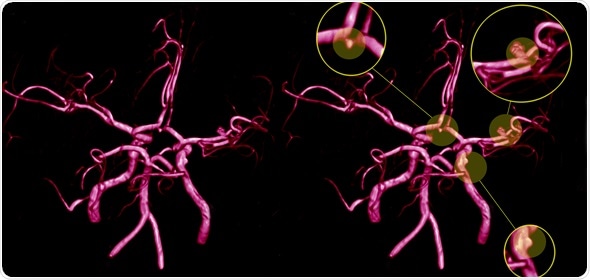Intracerebral hemorrhage (ICH) refers to bleeding around or within the brain when a blood vessel in the brain ruptures. Blood leaks into the brain causing tissue injury, which leads to stroke symptoms such as weakness, blindness, numbness in one side of the body and speech loss.
ICH is the second most common subtype of hemorrhagic stroke next to ischemic stroke and accounts for up to 27% of all strokes worldwide. Stroke is a leading cause of disability and the second most common cause of death worldwide.

Magnetic resonance imaging in ICH
Magnetic resonance imaging (MRI) is a technique that uses strong magnetic fields and radio waves to create images of the inside of a person’s body. An MRI scan can be used to generate a detailed 3-D reconstruction of the brain and obtain information such as hemorrhage volume in ICH. A recent study by Beilei Lei (Duke University Medical Center in Durham, US) and colleagues used Bruker BioSpin’s 7.0T MRI scanner for this purpose.
Hemorrhage and brain oxygen deprivation
The brain cannot store oxygen and instead relies on a network of blood vessels for its oxygen supply. Blood pooling into the brain tissue as a result of ICH deprives the brain of its oxygen supply. A hemorrhage only needs to interrupt blood flow and oxygen supply in the brain for a few minutes before brain cells start to die, which quickly leads to brain damage and puts a person’s life at risk.
ICH outcomes
ICH is associated with very poor neurological outcomes. Around 40 to 50% of patients die within 30 days of ICH and less than one third of those who survive return to being functionally independent. Although improvements have been made in other forms of acute central nervous system injury, there has been little progress in improving recovery rate after ICH and no effective treatment strategies have been developed.
The brain’s inflammatory responses to ICH lead to the development of cerebral edema, intracranial hypertension and neuronal damage. Therefore, the development of pharmacological solutions for reducing cerebral edema, neuroinflammation and secondary neuronal injury would provide answers to a significant, unmet medical need.
ApoE and ICH outcomes
Although outcomes following ICH are typically poor, they do vary significantly, which is likely to be an effect of genetic influences. For instance, polymorphism in the apolipoprotein E (apoE) gene seems to play a significant part in determining outcomes following ICH.
ApoE is the protein that combines with lipids to form lipoproteins, molecules responsible for packaging and carrying cholesterol and other lipids in the circulation. Maintaining a normal blood cholesterol level is essential to protecting against cardiovascular problems such as heart attack and stroke and there is a growing body of evidence that associates the apoE genotype with the incidence and outcomes of ICH.
For example, the major alleles of the apoE gene are APOE3, APOE3 and APOE4 and the presence of the APOE4 isoform is associated with increased neurological morbidity and cerebral edema, as well as being an independent risk factor for ICH in humans.
ApoE-derived peptides
It has been demonstrated that, in an isoform-specific manner, apoE modifies neuroinflammatory responses via its adaptive role in glial downregulation. However, the intact apoE holoprotein is too large to readily cross the blood-brain barrier (BBB), thereby limiting its therapeutic potential.
As a solution to this limitation, smaller peptides, of 12 to 20 amino acids, derived from the receptor binding region of apoE, have been created. These peptides, which can cross the BBB, share the anti-inflammatory and neuroprotective effects of the intact apoE holoprotein and have been shown to downregulate the brain’s inflammatory response in vitro and in vivo.
In murine models of brain injury, improved functional and histological outcomes have been demonstrated. These smaller peptides may represent a promising new therapeutic approach to ICH.
The CN-105 pentapeptide
Based on these developments, researchers Lei and colleagues recently created a small, 5-amino acid peptide, CN-105, that mimics the polar face of the apoE helical domain, which is involved in receptor interactions. To investigate whether this pentapeptide may have neuroprotective properties and improve functional outcomes after ICH, the team tested the peptide’s therapeutic potential in a murine model of collagenase-induced ICH.
One to five days after ICH induction, Rotarod latencies were increased among CN-105-treated mice, compared with saline-treated mice, indicating short-term improvement in vestibulomotor performance as a result of CN-105 treatment.
Twenty-nine to 32 days after ICH, the CN-105-treated mice also had reduced Morris water maze latencies compared with saline-treated mice, indicating long-term improvement in neurocognitive performance. Furthermore, the CN-105 treated mice had significantly reduced brain water content, decreased neuroinflammation and increased hippocampal CA3 neuronal survival.
CN-105 did not have any effect on hemorrhage volume, as indicated by magnetic resonance images obtained using Bruker BioSpin’s 7.0T MRI scanner and Paravision 5.1 imaging software. This MRI scanner can be applied across the full range of modern neuroimaging techniques including structural MRI, functional MRI, diffusion tensor MRI, perfusion MRI and multinuclear MR spectroscopy.
Lei and colleagues say the improved neurobehavioral outcomes, reduced edema and increased neuronal survival among mice treated with CN-105 after ICH together demonstrate the potential of CN-105 as a therapy for patients with ICH.
References
About Bruker BioSpin - NMR, EPR and Imaging

Bruker BioSpin offers the world's most comprehensive range of NMR and EPR spectroscopy and preclinical research tools. Bruker BioSpin develops, manufactures and supplies technology to research establishments, commercial enterprises and multi-national corporations across countless industries and fields of expertise.
Sponsored Content Policy: News-Medical.net publishes articles and related content that may be derived from sources where we have existing commercial relationships, provided such content adds value to the core editorial ethos of News-Medical.Net which is to educate and inform site visitors interested in medical research, science, medical devices and treatments.